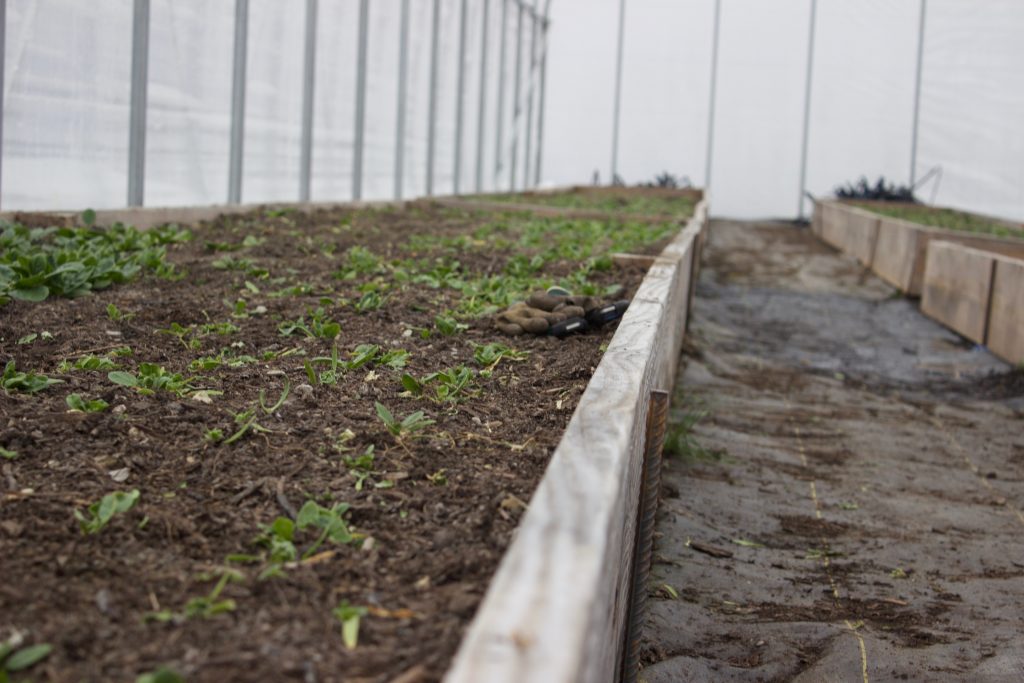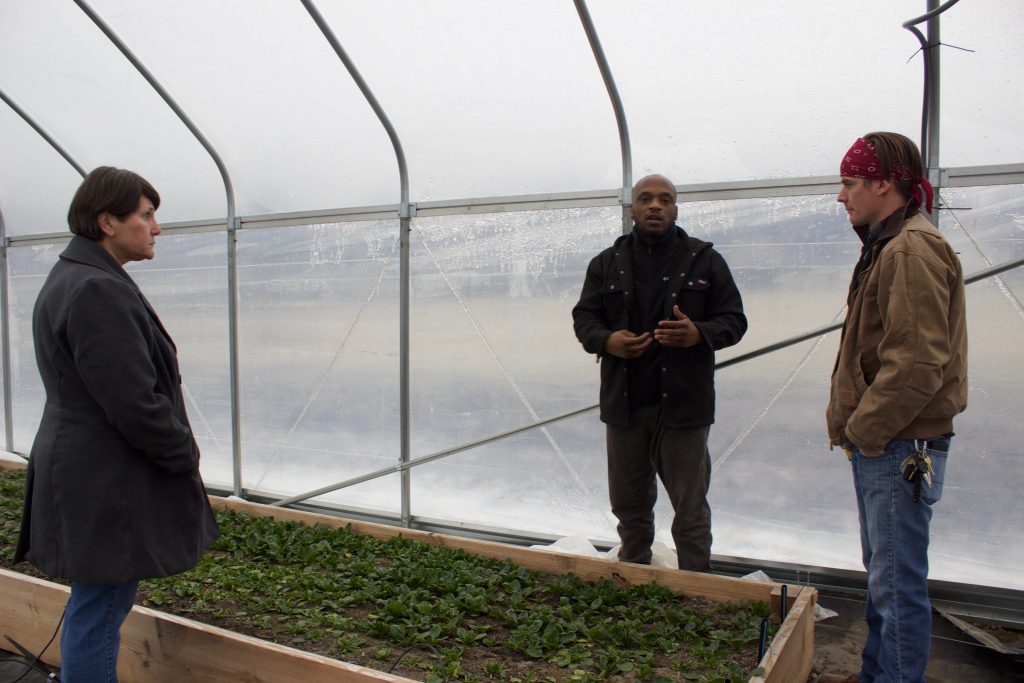
MANSFIELD, Ohio — Walter Bonham, owner of The Food Lab, in Mansfield, was not always a farmer. There aren’t many farmers in Mansfield. It’s a city, and agriculture has not traditionally been one of the city’s industries.
But that could be changing. Bonham, along with nine other new farmers, spent 2019 learning how to manage microfarms, through training from Ohio State University. These farmers are getting ready to start their first full year of growing.
The microfarms are intensive growing systems that use high tunnels to produce year-round, along with some raised beds to grow outside in the summer.
Six of them went into the community in 2019, and four more will be added this year.
Getting started as a farmer usually involves loans for buying land or equipment. These farmers, however, have the opportunity to get started at the cost of only their time and labor, as participants in an urban sustainable food system project through Ohio State.
The project, developed by Ohio State associate professor Kip Curtis, received a $2 million matching grant from the Foundation for Food and Agriculture Research in spring 2019, two years after Ohio State built its own microfarm on the Mansfield campus.
The grant supports the project’s launch over three years, covering the costs of building infrastructure and getting equipment. Community groups, including the North End Community Improvement Collaborative, which had talked about food systems as a way to boost the area’s economy even before Curtis brought up the idea, helped support the grant match.
For those three years, Ohio State directs the project and measures the impacts it has on the city. At the end of the three years, Bonham and the other farmers get to keep the resources that the grant funded and keep farming.
Cooperative
The 10 farmers in the program are not competing with each other. They are all members of the Richland Gro-Op cooperative, a group established as part of the project in 2019. Through the cooperative, farmers will sell to larger, institutional buyers together.
“The farmer’s mission and goal is to provide the best crop they can,” Bonham said.
The cooperative handles everything else, including marketing and finding buyers. The marketing director assigns farmers crops to grow.
“We’re never, ever growing anything without having a place to sell it,” Bonham said. “It creates a huge peace of mind as a farmer. Instead of us all having to go hustle our vegetables locally, we have a for-sure buyer.”
Farmers still have the freedom to take some produce to farmers markets or start CSAs, but they do not have to rely on each carving out small markets in the area.

Economy
The goal of the project isn’t just to make more local food available in Mansfield. It aims to give the city an economic boost by tapping into agriculture, an industry that was not previously being explored in the area, and to help address food insecurity.
“There was nobody selling spinach … in this area,” Bonham said. “It provides economic opportunities for local people right here in the community.”
Four of the farms, including Bonham’s farm and the farm NECIC owns, are based on a 12-acre plot in Mansfield that Gorman-Rupp leased to NECIC for just $1 per year for five years. The company used to have a manufacturing facility there, but moved it. Before the farms went in, the plot was just a brown field.
Each of the farms, which include two high tunnels and some outdoor growing space for the summer, are designed to eventually be managed by a single person in 20-30 hours per week, and could bring in an income of about $30,000 per year, Curtis said. So, people could farm while also working another job, or retirees, stay-at-home parents or people re-entering the workforce after incarceration could have a stable source of income.
“The idea is, address food insecurity not by giving away food, but by putting dollars in the pockets of those people who are food insecure,” Curtis said. “So you do it … by teaching them how to sell food. Food insecurity is not about there not being enough vegetables. Food insecurity is about somebody not having enough money. It’s about poverty. So you address poverty by getting people jobs.”
The hope is that a productive farming cooperative could help fill some of the holes left when manufacturing jobs largely moved on from the city.
Learning
Most of the farmers had little or no experience with farming before getting involved, according to Dana Hilfinger, of Ohio State, who developed and helped run the training. But that may have been an advantage.
The farmers were not settled into their own way of doing things. They were open to being part of the cooperative. They were eager to learn.
“It’s been a really positive experience,” Hilfinger said. “I think lots of traits that you need to be a successful grower are not just about knowing plants, but come to your organization skills and problem-solving skills and reliability.”
The farmers started planting their first full crops in September.
“It’s been an awesome journey with everybody … I kind of remember when all of this was a conversation,” Bonham said. “It’s been really beautiful seeing everything come together.”

Farmers
Bonham, who is also one of the board directors for the Richland Gro-Op, was drawn to the project because of his background in catering and cooking.
“I felt like it went hand-in-hand, serving food and growing food,” he said. “My model is build, grow, feed.”
Marqua Myers, one of the rural farmers, got involved partly because of her late husband. He was a teacher in Mansfield for 30 years. After he died, and after she retired, she needed something to fill her time.
“He said that education was the great equalizer,” she said. “I thought it would be keeping his legacy going if I did something to help the kids he used to teach.”
Myers’s farm will be built this year at her home in Bellville, Ohio. She has been training with another cooperative member, Jennifer Johnson, who has her own rural microfarm near Bellville.
Bonham, Justin Ocheltree, who manages NECIC’s farm, and Myers gathered at the plot where NECIC’s and Bonham’s farms are located on a cold, icy day in February.
The farmers spent 2019 turning the plot into a farm: getting high tunnels constructed and bringing water and electricity to the facilities.
Each farmer’s high tunnels have small differences. One of the high tunnels Ocheltree manages has a fake raven, named Edgar, taped up near the top of the tunnel. In another, managed by Vincent Owens, of Fulfillment Farms, a whiteboard reads “Welcome to Fulfillment Farms Ltd, where farming dreams come true!”
“Kind of another benefit of having the co-op is the collective support,” Bonham said.
Myers said the other farmers in the project got together and harvested the tunnel she has been growing in after her mother passed away recently.
“I don’t think anybody’s ever said ‘no’ when I asked for help,” she said.

Future
Bonham and the other farmers are hoping to put together a farmers market and offer more educational opportunities for local schools and colleges this year. They are also figuring out how to use the rest of the 12-acre plot his farm sits on.
Because the farmers were able to avoid the typical loans that come with starting a farm, Curtis believes the cooperative will become sustainable within the three years that the grant supports the project.
After building four more farms this spring, Curtis said, the goal is to add another six farms and farmers to manage them. Right now, with 10 farmers, the cooperative is on track to break even and start making a profit by the end of the third year. With 16 farmers, it could be there by the end of the second year.
Curtis is currently looking for more funding through other grant programs to support adding more farms.









